Lifestyle
Amber Glenn Is Carving a New Path for Figure Skaters

When Amber Glenn was named the top U.S. women’s figure skater for a second consecutive year in January, she collapsed in tears, releasing mountains of pressure that had been weighing on her chiseled shoulders.
This week, she is aiming to add another gold medal to her pile at the World Figure Skating Championships in Boston. If she pulls it off, Ms. Glenn would finish her season an undefeated champion and become the first American figure skater to claim the women’s World Championship title in almost 20 years.
It would be Ms. Glenn’s biggest win yet, but only the latest in a series of firsts for a woman who has landed the triple axel jump in all of her competitions this season — one that, for Ms. Glenn, has been filled with triumph and tragedy after a plane crash in January killed 11 figure skaters, some of whom she had shared the ice with just days before they died.
If Ms. Glenn wins or even medals at Worlds, she will be the first openly L.G.B.T.Q. woman to do so in a sport whose female athletes largely tend to mold their likenesses to that of a cookie-cutter ice queen.
Ms. Glenn, by contrast, has grown her profile by celebrating what makes her different.
She is a pansexual figure skater who jumps with the power of a pole-vaulter, models her hairstyles off those of brassy pop stars, collects lightsabers — and is primed to be America’s next big skating star at 25, an age when most of her peers have long retired.
A Story of Perseverance
On a Saturday evening in February, Ms. Glenn darted around the corners of the ice rink at Chelsea Piers in Manhattan at double-digit speeds as her short-program music — “This Time” by Janet Jackson — blared from loudspeakers. She was in New York to fine-tune some of her choreography before the World Championships this month.
Ms. Glenn’s girlish freckles were offset by graphic winged eyeliner and blond hair that trailed behind her like a parachute as she skated.
Earlier that day, Ms. Glenn said in an interview that the last eight months had “been a lot.” She began training for the current season last spring and won her first gold medal last September at the Lombardia Trophy competition in Bergamo, Italy.
She has not stopped winning since. Over the course of several weeks last November and December, Ms. Glenn traversed the globe numerous times, earning first place in three major competitions that included the Grand Prix Final in Grenoble, France, where on Dec. 7 she became the first American woman to be crowned champion in 14 years.
Two weeks later, she clinched gold at Nationals in Wichita, Kan., by a slim margin.
But Ms. Glenn’s career, which began more than two decades ago at an ice rink inside a shopping mall, has not been a linear ride to the top.
At 14, she became the U.S. junior women’s champion. About a year later, Ms. Glenn was hospitalized for depression and anxiety, which stopped her from skating for five months. At the time, she was also restricting her eating — consuming one or two Lean Cuisine meals a day. In more recent years, she has suffered multiple severe concussions and has been haunted by mistakes, like missed jumps, that she has attributed to anxiety. It has not helped that many of her injuries and stumbles have played out on live television.
Terry Gannon, an NBC sports commentator who has called nationally televised figure-skating events since the 1990s, attributed Ms. Glenn’s successes this season to perseverance.
“I feel like I have lived this journey with her and watched her through the years knowing she had the ability but coming up short,” said Mr. Gannon, who described Ms. Glenn’s story as emotionally satisfying to viewers. “Now we see her break through at the highest level,” he added.
Her winning season harks back to the time when American skaters like Dorothy Hamill and Michelle Kwan dominated the sport. As a rising star of women’s singles, figure skating’s marquee event, Ms. Glenn has created some fresh buzz in the run-up to next year’s Milan-Cortina Winter Olympics. “It’s hugely important to the success of American skating to have a star who has a chance to win” at the Olympics, Mr. Gannon said.
Sasha Cohen was the last American to do so, earning a silver medal at the Turin Winter Olympics in 2006. If Ms. Glenn’s winning streak carries into next year, when Team USA skaters are determined, the country may have its next best chance at an Olympic medal.
Mastering the Triple Axel
On the ice, Ms. Glenn has become known for certain hallmarks: Landing jumps with her arms stretched vertically in a dramatic V-shape, wearing the dark lipstick of a prima ballerina, performing with a mane of multiple ponytails that she says is inspired by the pop star Kesha.
While she skates with an easy elegance, her approach to the sport has often been described using words like “explosive” and “aggressive.” “That is usually a trademark of men’s skating, they are allowed to be aggressive and muscled,” said Kaitlyn Weaver, 35, a champion ice dancer and two-time Olympian who is now a choreographer for Ms. Glenn.
Ms. Glenn said she had leaned into athleticism rather than “conforming to look smaller.” This approach is embodied by her embrace of the triple axel, a feat in which skaters hurl themselves face-forward into the air and rotate 1,260 degrees before landing backward on a single foot. Ms. Glenn has been the only women’s skater of her level to land a ratified triple axel this season in international competition, according to the International Skating Union.
Ms. Glenn’s free skate program at last year’s World Championships began with a perfect triple axel — and ended in multiple spills onto the ice. She ultimately finished in 10th place, a result that she attributed to her anxiety flaring up during her program. “My brain didn’t know the difference between competing and having to fight a bear,” as she put it.
Last summer, Ms. Glenn began integrating neurotherapy into her two-hour practices as a way to mitigate her performance anxiety. She wires herself to a device that tracks her heart rate and brain waves, which helps visualize when her anxiety spikes.
Caroline Silby, a sport psychology consultant who works with skaters worldwide, suggested neurotherapy to Ms. Glenn. “Throughout her career, she’s always had moments of brilliance, it wasn’t like she wasn’t doing it.” Ms. Silby said. “She just wasn’t doing it consistently.”
She added, “When the whole world talks about how you can’t do the second half of your program, it’s about ‘OK, how can we get the brain to stay quiet?’”
Embracing Her Identity
Ms. Glenn’s mother, Cathlene Glenn, said there had always been hints that her daughter was different from other girls her age when she was growing up in Plano, Texas. Among them: Ms. Glenn, who began skating as a 5-year-old at the rink inside the nearby Stonebriar Centre mall, gravitated toward dinosaur toys over dolls, her mother said.
She added that, by the time Ms. Glenn had turned 8, coaches were remarking that she had exceptional talent. By 11, she had mastered every triple jump except the axel.
But in a sport in which an intermediate pair of skates can cost $800, the money required to keep Ms. Glenn skating at a high level became a source of friction for her parents. To save on lessons and rink fees, her mother worked as a nanny for a former coach of Ms. Glenn’s and at the front desk of the mall ice rink. Her father, Richard Glenn, a law enforcement officer, worked overtime and took outside jobs doing security at movie theaters and hospitals.
Ms. Glenn, for her part, said she did not tell her parents when she was outgrowing her skates. “I still have the bunions and scars to prove it,” she said.
These days, she wears pairs that can cost around $1,500 — and she gets them for free from Jackson Ultima, which uses her image in promotional campaigns.
At Chelsea Piers, her skates’ blades were pushed to the limit as she ripped into the ice with expansive lunges and razor-sharp turns. She typically practices at the Broadmoor World Arena, a U.S. Olympic training site in Colorado Springs, Colo., not far from her home in the city. Above the rink, a flag with Ms. Glenn’s name flies alongside others bearing the names of fellow American champions like Peggy Fleming.
Ms. Glenn’s reputation as a different kind of skater was bolstered in 2019, when she opened up about her pansexual identity in an article for Dallas Voice magazine. Months after it was published, she arrived at Nationals in 2020 to see dozens of fans in the stands holding the Pride flag in her honor.
Ms. Weaver, who at the time had not yet started working as a choreographer with Ms. Glenn, recalled watching the scene on TV and “weeping.” In 2021, Ms. Weaver became the first Olympic female skater to publicly come out as queer. “We work against a stereotype,” she said, likening openly queer female skaters to openly gay N.F.L. players.
Having learned to be more comfortable in her skin, Ms. Glenn now holds a pride flag when she skates a victory lap at competitions. Lately, she had been thinking about the ways she could help people like herself at a time in which Ms. Glenn said “identities are being erased.”
“Sometimes, I’m looking at the world where we are taking so many steps back,” she added. “I want to be part of the people who keep us moving forward.”
She was speaking on a video call in late February from her apartment in Colorado Springs, which Ms. Glenn shares with her dog, Uki, a schipperke who, like Ms. Glenn, has learned to spin on demand.
Tragedies Amid Triumphs
Around Ms. Glenn’s apartment are items that offer glimpses of her personality. There are lightsabers hung on a wall (she is a fan of “Star Wars”) and a cabinet filled with Magic the Gathering and Pokémon cards. Instead of real flowers, she decorates the space with Lego floral arrangements because of her travel schedule. “It’s nice to have ones that stick around,” she said.
She moved to “the Springs” in the summer of 2022, she said, to work with top coaches — and to take advantage of free physical therapy and personal training sessions offered by the area’s Olympic training site, which are subsidized by organizations including the U.S. Olympic and Paralympic Committee. It’s also the first time Ms. Glenn has lived on her own.
Her main coach, Damon Allen, said Ms. Glenn’s newly independent lifestyle has helped shift her competitive course. Mr. Allen, 51, will accompany her to the World Championships. “The preparation is the same we have been doing all year,” he said. “We are keeping it simple.”
To earn the women’s singles gold medal, she will need to defeat Kaori Sakamoto, 24, the Japanese skater who has won it the last three years.
Skaters of Ms. Sakamoto’s and Ms. Glenn’s age have historically been rare sights atop the championship podiums in women’s figure skating, a sport in which the last three Olympic gold medalists were between the ages of 15 and 17 when they won. In the wake of a doping scandal involving a 15-year-old Russian skater that rocked the Beijing Winter Olympics in 2022, the minimum age for female skaters to compete in the games was raised to 17.
At Ms. Glenn’s training rink, she refers to herself as the “fun aunt,” Mr. Allen said. Her friend Gracie Gold, 29, a retired two-time national champion who has spoken about her own struggles as a skater, jokingly said that late bloomers in the sport like Ms. Glenn were “only weird to people in skating that need to go outside and touch grass.”
“I don’t think hockey or football would be as popular if the general public was watching 14-year-old boys do it,” Ms. Gold added.
She is one of many skaters whom Ms. Glenn has fostered friendships with. Through gestures like bringing flowers to fellow athletes at practices, Ms. Glenn has tried to bolster camaraderie in a sport known for a cutthroat culture, which has been embodied by instances like the Olympian Nancy Kerrigan being clubbed in the knee in a hit ordered by a man who was then married to a rival skater.
Ms. Glenn, who was home-schooled from the second grade through her senior year of high school, said she learned social cues largely by being around other young people at the mall where she started skating.
Her kind overtures to peers were motivated by Ms. Glenn’s experiences at competitions during her early days in the sport. “I remember feeling so scared,” she said. “I thought, I don’t want to feel like this. If one day I’m able to, I want to help everyone to be comfortable.’
When the recent plane crash killed a group of 28 athletes, parents and personnel affiliated with U.S. Figure Skating, “it broke my heart,” Ms. Glenn said — especially because of what she had told some of the young skaters while practicing with them about 72 hours before the crash.
“What hit me so hard is I told them to make friends that they would have for the rest of their life,” she said.
Earlier this month, Ms. Glenn participated in Legacy on Ice, a nationally televised event honoring the victims of the plane crash. Days before, her grandmother Barbara Glenn, a longtime rink-side presence at her competitions, died.
“She loves to skate with emotion,” Ms. Glenn’s mother said. “She wants to feel her feelings out on the ice. I think that skate was very therapeutic for her.” The death of Ms. Glenn’s childhood dog, Ginger, this month was another emotional blow.
In a phone interview on Saturday, Ms. Glenn said that the grief she had lately experienced had given her a new perspective going into the World Championships.
“I get upset about my mistakes,” she said. “But there are so many other things that are more serious.”

Lifestyle
In Brooklyn’s Park Slope neighborhood, children’s entertainment comes with strings

The Tin Soldier, one of Nicolas Coppola’s marionette puppets, is the main character in The Steadfast Tin Soldier show at Coppola’s Puppetworks theater in Brooklyn’s Park Slope neighborhood.
Anh Nguyen for NPR
hide caption
toggle caption
Anh Nguyen for NPR
Every weekend, at 12:30 or 2:30 p.m., children gather on foam mats and colored blocks to watch wooden renditions of The Tortoise and the Hare, Pinocchio and Aladdin for exactly 45 minutes — the length of one side of a cassette tape. “This isn’t a screen! It’s for reals happenin’ back there!” Alyssa Parkhurst, a 24-year-old puppeteer, says before each show. For most of the theater’s patrons, this is their first experience with live entertainment.
Puppetworks has served Brooklyn’s Park Slope neighborhood for over 30 years. Many of its current regulars are the grandchildren of early patrons of the theater. Its founder and artistic director, 90-year-old Nicolas Coppola, has been a professional puppeteer since 1954.
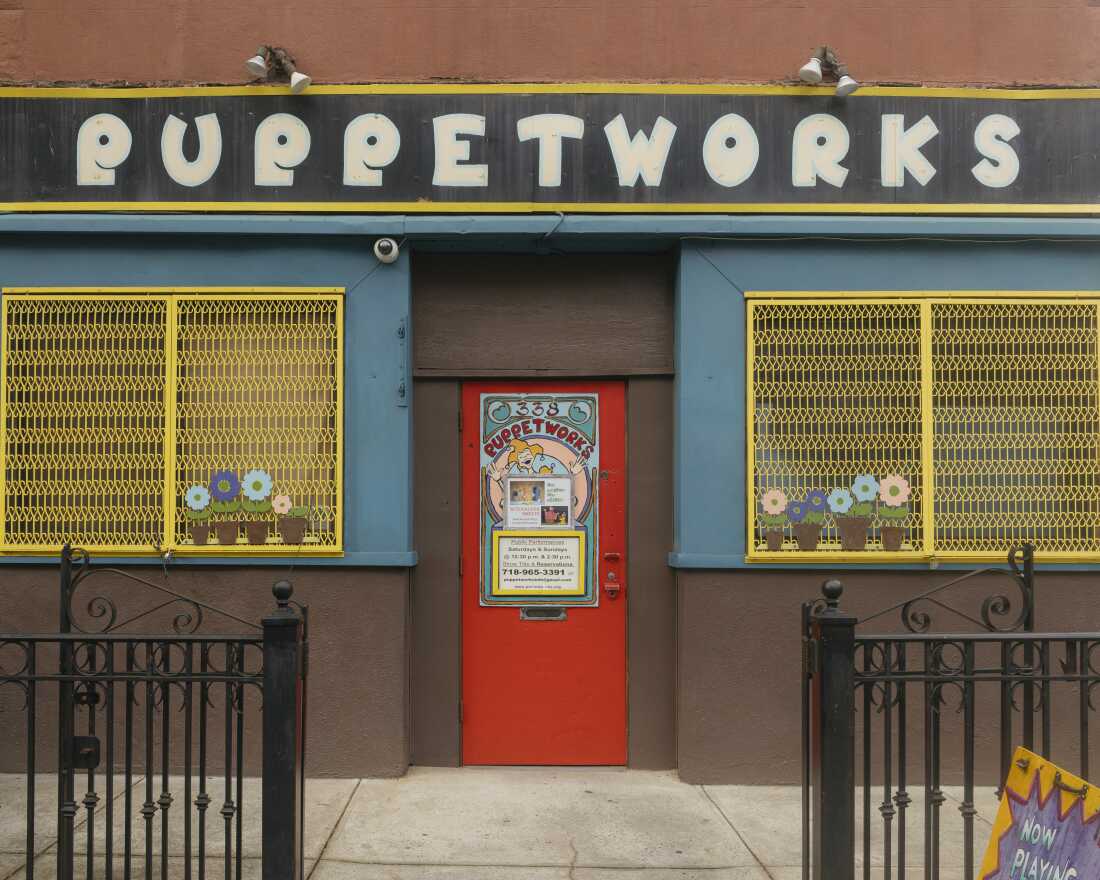
The Puppetworks theater in Brooklyn’s Park Slope neighborhood.
Anh Nguyen for NPR
hide caption
toggle caption
Anh Nguyen for NPR

A workshop station behind the stage at Puppetworks, where puppets are stored and repaired.
Anh Nguyen for NPR
hide caption
toggle caption
Anh Nguyen for NPR
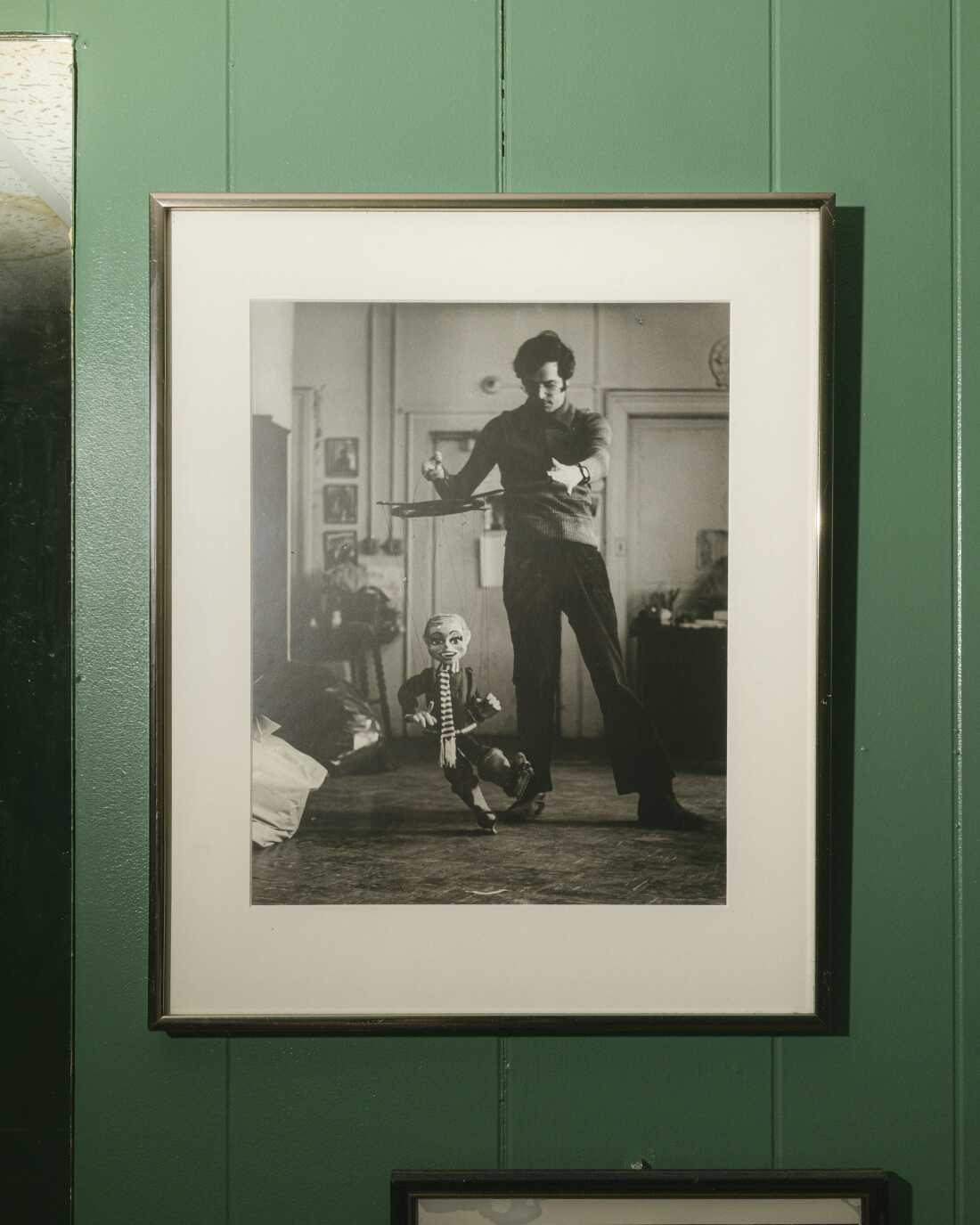
A picture of Nicolas Coppola, Puppetworks’ founder and artistic director, from 1970, in which he’s demonstrating an ice skater marionette puppet.
Anh Nguyen for NPR
hide caption
toggle caption
Anh Nguyen for NPR
For just $11 a seat ($12 for adults), puppets of all types — marionette, swing, hand and rod — take turns transporting patrons back to the ’80s, when most of Puppetworks’ puppets were made and the audio tracks were taped. Century-old stories are brought back to life. Some even with a modern twist.
Since Coppola started the theater, changes have been made to the theater’s repertoire of shows to better meet the cultural moment. The biggest change was the characterization of princesses in the ’60s and ’70s, Coppola says: “Now, we’re a little more enlightened.”

Right: Michael Jones, Puppetworks’ newest puppeteer, poses for a photo with Jack-a-Napes, one of the main characters in The Steadfast Tin Soldier. Left: A demonstration marionette puppet, used for showing children how movement and control works.
Anh Nguyen for NPR
hide caption
toggle caption
Anh Nguyen for NPR

Marionette puppets from previous Puppetworks shows hang on one of the theater’s walls.
Anh Nguyen for NPR
hide caption
toggle caption
Anh Nguyen for NPR

A child attends Puppetworks’ 12:30 p.m. showing on Saturday, Dec. 6, dressed in holiday attire that features the ballerina and tin soldier in The Steadfast Tin Soldier.
Anh Nguyen for NPR
hide caption
toggle caption
Anh Nguyen for NPR
Streaming has also influenced the theater’s selection of shows. Puppetworks recently brought back Rumpelstiltskin after the tale was repopularized following Dreamworks’ release of the Shrek film franchise.
Most of the parents in attendance find out about the theater through word of mouth or school visits, where Puppetworks’ team puts on shows throughout the week. Many say they take an interest in the establishment for its ability to peel their children away from screens.
Whitney Sprayberry was introduced to Puppetworks by her husband, who grew up in the neighborhood. “My husband and I are both artists, so we much prefer live entertainment. We allow screens, but are mindful of what we’re watching and how often.”

Left: Puppetworks’ current manager of stage operations, Jamie Moore, who joined the team in the early 2000s as a puppeteer, holds an otter hand puppet from their holiday show. Right: A Pinocchio mask hangs behind the ticket booth at Puppetworks’ entrance.
Anh Nguyen for NPR
hide caption
toggle caption
Anh Nguyen for NPR
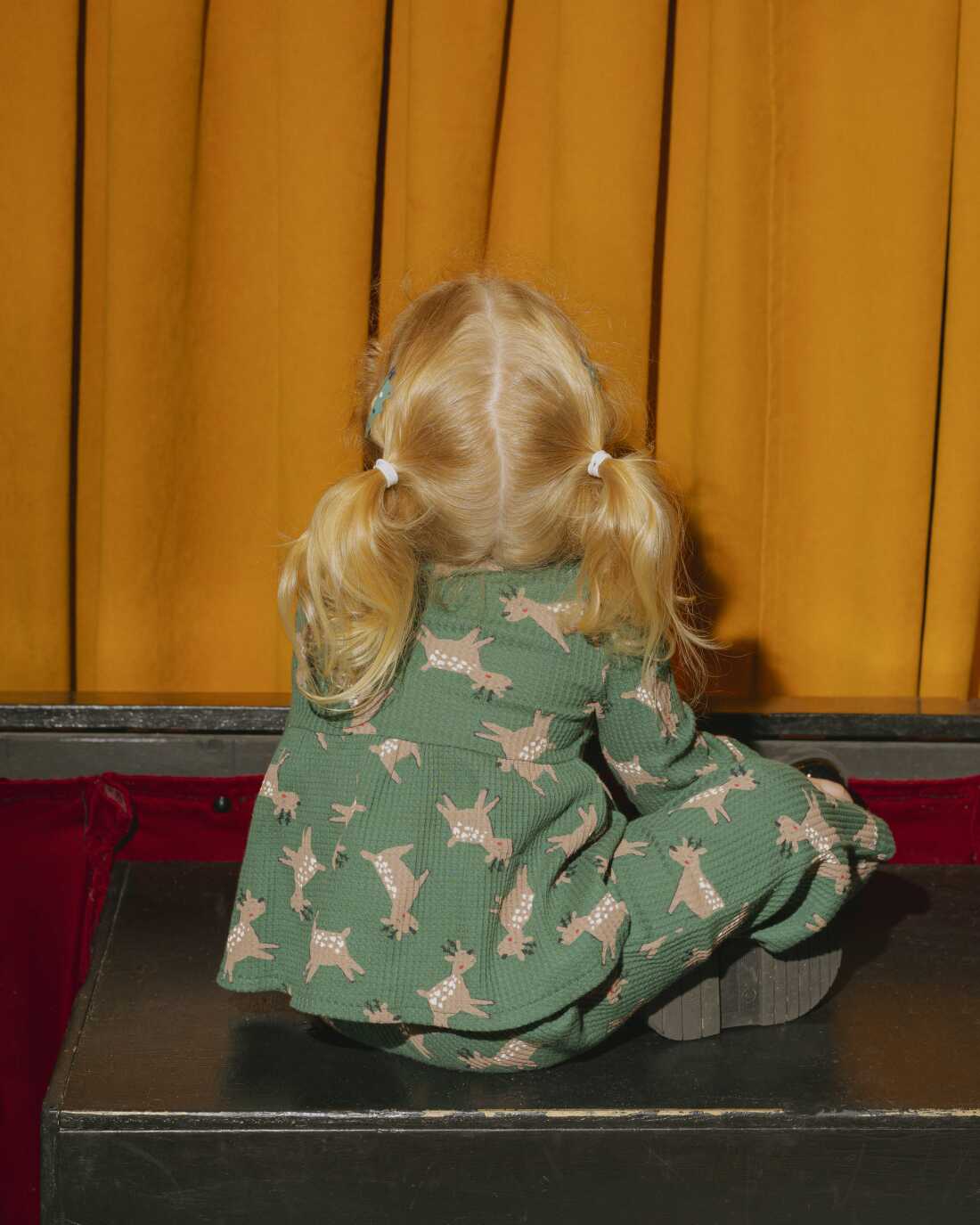
A child attends Puppetworks’ 12:30 p.m. showing on Saturday, Dec. 6, dressed in holiday attire.
Anh Nguyen for NPR
hide caption
toggle caption
Anh Nguyen for NPR

Left: Two gingerbread people, characters in one of Puppetworks’ holiday skits. Right: Ronny Wasserstrom, a swing puppeteer and one of Puppetworks’ first puppeteers, holds a “talking head” puppet he made, wearing matching shirts.
Anh Nguyen for NPR
hide caption
toggle caption
Anh Nguyen for NPR
Other parents in the audience say they found the theater through one of Ronny Wasserstrom’s shows. Wasserstrom, one of Puppetworks’ first puppeteers, regularly performs for free at a nearby park.
Coppola says he isn’t a Luddite — he’s fascinated by animation’s endless possibilities, but cautions of how it could limit a child’s imagination. “The part of theater they’re not getting by being on the phone is the sense of community. In our small way, we’re keeping that going.”
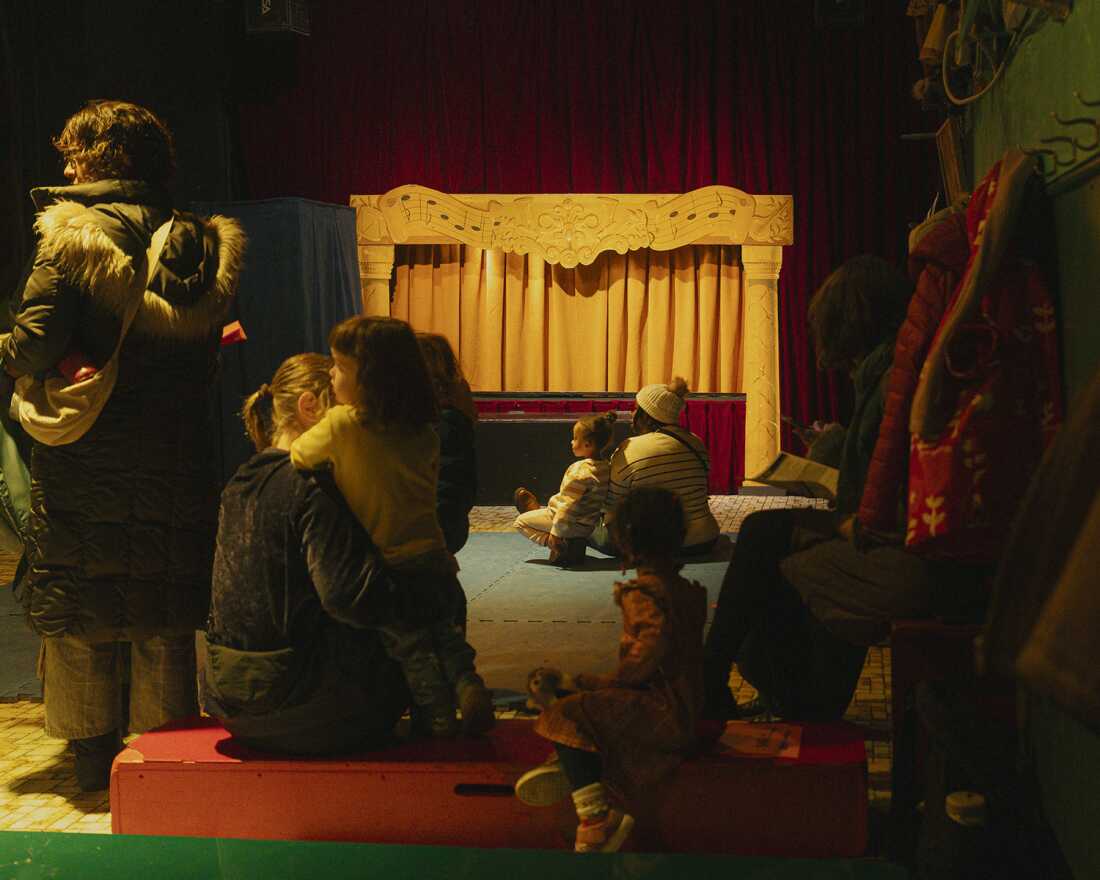
Puppetworks’ 12:30 p.m. showing of The Steadfast Tin Soldier and The Nutcracker Sweets on Saturday, Dec. 6.
Anh Nguyen for NPR
hide caption
toggle caption
Anh Nguyen for NPR
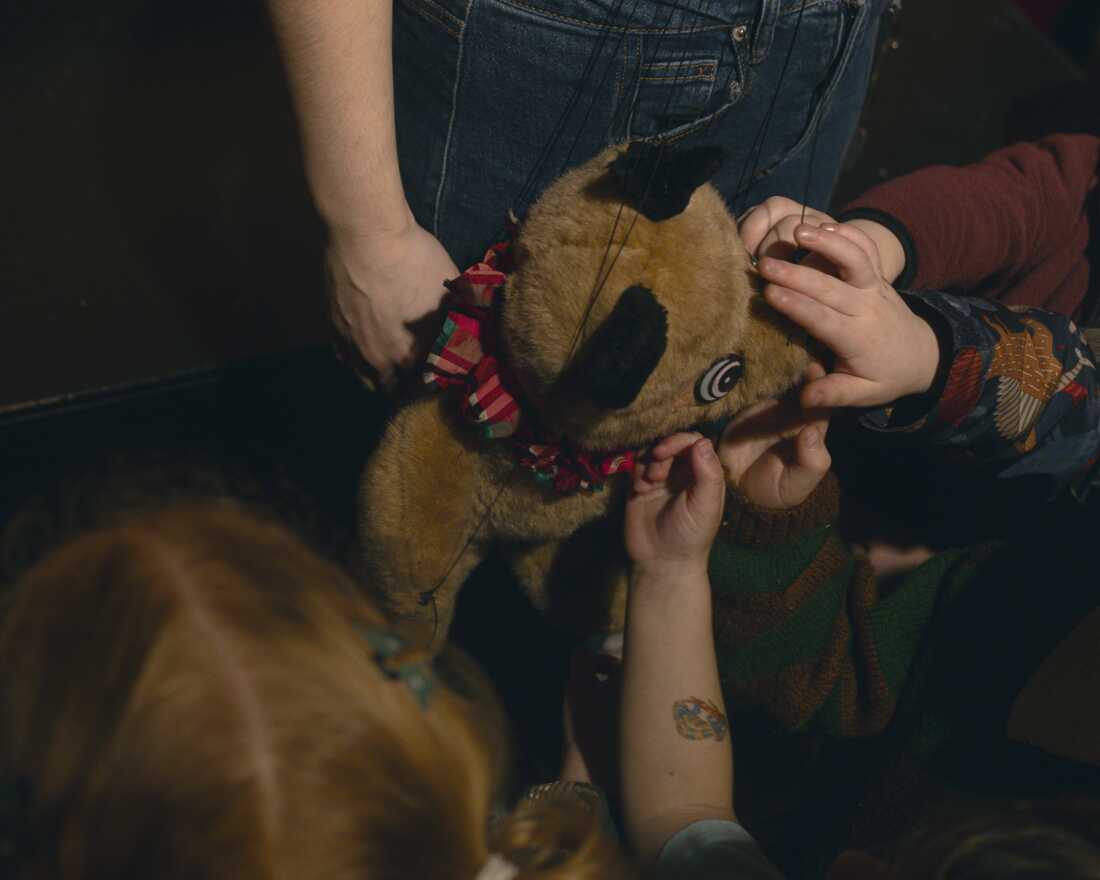
Children get a chance to see one of the puppets in The Steadfast Tin Soldier up close after a show.
Anh Nguyen for NPR
hide caption
toggle caption
Anh Nguyen for NPR
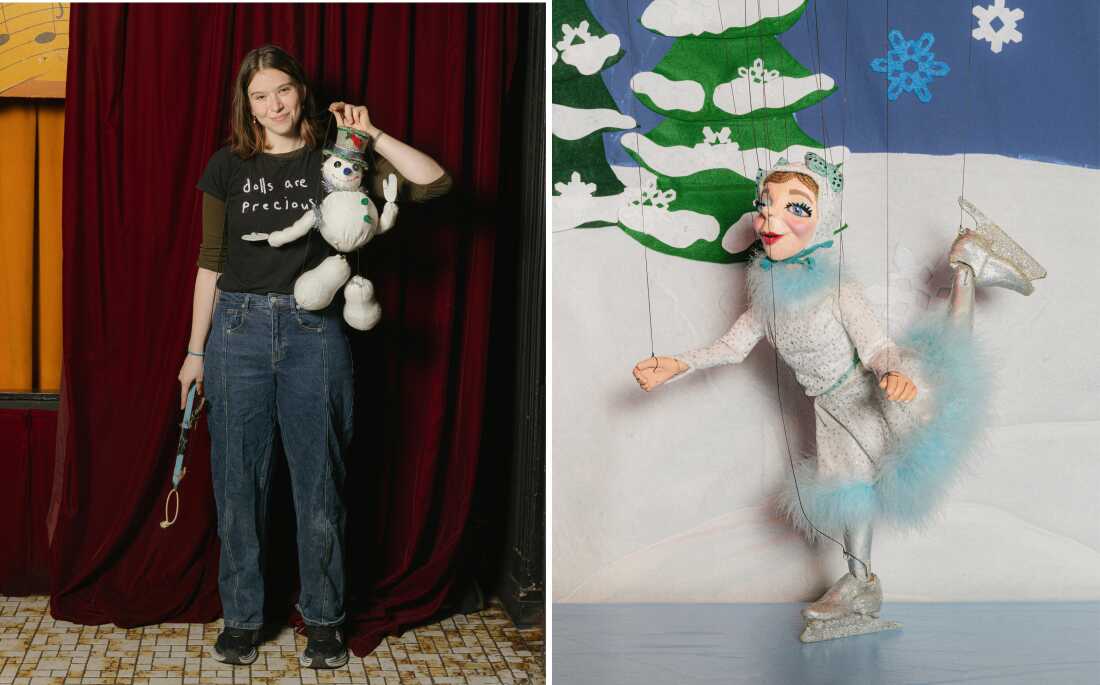
Left: Alyssa Parkhurst, Puppetworks’ youngest puppeteer, holds a snowman marionette puppet, a character in the theater’s holiday show. Right: An ice skater, a dancing character in one of Puppetworks’ holiday skits.
Anh Nguyen for NPR
hide caption
toggle caption
Anh Nguyen for NPR
Community is what keeps Sabrina Chap, the mother of 4-year-old Vida, a regular at Puppetworks. Every couple of weeks, when Puppetworks puts on a new show, she rallies a large group to attend. “It’s a way I connect all the parents in the neighborhood whose kids go to different schools,” she said. “A lot of these kids live within a block of each other.”

Three candy canes — dancing characters in one of Puppetworks’ holiday skits — wait to be repaired after a show.
Anh Nguyen for NPR
hide caption
toggle caption
Anh Nguyen for NPR
Anh Nguyen is a photographer based in Brooklyn, N.Y. You can see more of her work online, at nguyenminhanh.com , or on Instagram, at @minhanhnguyenn. Tiffany Ng is a tech and culture writer. Find more of her work on her website, breakfastatmyhouse.com.
Lifestyle
The Best of BoF 2025: Fashion’s Year of Designer Revamps

Lifestyle
Best Christmas gift I ever received : Pop Culture Happy Hour

-

 Iowa1 week ago
Iowa1 week agoAddy Brown motivated to step up in Audi Crooks’ absence vs. UNI
-

 Maine1 week ago
Maine1 week agoElementary-aged student killed in school bus crash in southern Maine
-

 Maryland1 week ago
Maryland1 week agoFrigid temperatures to start the week in Maryland
-

 New Mexico1 week ago
New Mexico1 week agoFamily clarifies why they believe missing New Mexico man is dead
-

 South Dakota1 week ago
South Dakota1 week agoNature: Snow in South Dakota
-

 Detroit, MI1 week ago
Detroit, MI1 week ago‘Love being a pedo’: Metro Detroit doctor, attorney, therapist accused in web of child porn chats
-

 Health1 week ago
Health1 week ago‘Aggressive’ new flu variant sweeps globe as doctors warn of severe symptoms
-

 Maine1 week ago
Maine1 week agoFamily in Maine host food pantry for deer | Hand Off

























